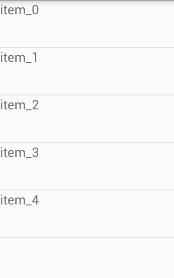目录
- 操作环境
- 导读
- 源码
- 实例
操作环境
- 操作系统:win7-64bit 旗舰版
- android 版本:android-23
- 模拟器:海马玩模拟器 0.9.0 Beta
导读
ArrayAdapter 是 BaseAdapter 的封装,目的是简化 Adapter 的继承复写等。ArrayAdapter 默认情况下希望你仅提供只有一个 TextView 的 item 布局;当然,如果布局内容远远不止于此,可以增加一个参数,该参数用于描述将要使用的 TextView。
源码
- 构造函数:
public ArrayAdapter(Context context, @LayoutRes int resource)
public ArrayAdapter(Context context, @LayoutRes int resource, @IdRes int textViewResourceId)public ArrayAdapter(Context context, @LayoutRes int resource, @NonNull T[] objects)
public ArrayAdapter(Context context, @LayoutRes int resource, @IdRes int textViewResourceId,
@NonNull T[] objects)public ArrayAdapter(Context context, @LayoutRes int resource, @NonNull List<T> objects)
public ArrayAdapter(Context context, @LayoutRes int resource, @IdRes int textViewResourceId,
@NonNull List<T> objects) - getView 方法:
/**
* {@inheritDoc}
*/
public View getView(int position, View convertView, ViewGroup parent) {
return createViewFromResource(mInflater, position, convertView, parent, mResource);
}
private View createViewFromResource(LayoutInflater inflater, int position, View convertView,
ViewGroup parent, int resource) {
View view;
TextView text;
if (convertView == null) {
view = inflater.inflate(resource, parent, false);
} else {
view = convertView;
}
try {
if (mFieldId == 0) {
// If no custom field is assigned, assume the whole resource is a TextView
text = (TextView) view;
} else {
// Otherwise, find the TextView field within the layout
text = (TextView) view.findViewById(mFieldId);
}
} catch (ClassCastException e) {
Log.e("ArrayAdapter", "You must supply a resource ID for a TextView");
throw new IllegalStateException(
"ArrayAdapter requires the resource ID to be a TextView", e);
}
T item = getItem(position);
if (item instanceof CharSequence) {
text.setText((CharSequence)item);
} else {
text.setText(item.toString());
}
return view;
}简单说明:
构造方法:
- 参数 @LayoutRes int resource: item 布局对应的布局文件;
- 参数 @IdRes int textViewResourceId: 布局文件对应的 TextView 控件Id,如果不传入该参数,则默认值为0;
getView 方法:
- 如果 View convertView 非 null,则继续使用它;否则,通过 inflater.inflate( resource, parent, false ) 方式创建新的;
- 【此处高能】:简单说就是 ArrayAdapter 只接受 TextView 或其衍生类来设置数据映射
- 如果未指定 textViewResourceId,则会将 convertView 强转成 TextView;
- 否则,通过 findViewById 将其从布局文件中找到后 强转成 TextView;
- 将数据集中对应的元素转成String 或 CharSequence之后设置到 TextView 系列控件;
实例
- test_item.xml:
<?xml version="1.0" encoding="utf-8"?>
<LinearLayout xmlns:android="http://schemas.android.com/apk/res/android"
android:orientation="vertical"
android:layout_width="match_parent"
android:layout_height="match_parent">
<TextView android:id="@+id/tv_content"
android:layout_width="match_parent"
android:layout_height="50dp"
/>
</LinearLayout>- test_array_adapter.xml:
<?xml version="1.0" encoding="utf-8"?>
<LinearLayout xmlns:android="http://schemas.android.com/apk/res/android"
android:orientation="vertical"
android:layout_width="match_parent"
android:layout_height="match_parent">
<ListView android:id="@+id/lv_test"
android:layout_width="match_parent"
android:layout_height="match_parent">
</ListView>
</LinearLayout>- MainActivity.java:
public class MainActivity extends Activity {
@Override
protected void onCreate(Bundle savedInstanceState) {
super.onCreate(savedInstanceState);
setContentView(R.layout.test_array_adapter);
this.testArrayAdatper();
}
// 测试 ArrayAdapter
void testArrayAdatper(){
ListView lv = (ListView)this.findViewById(R.id.lv_test);
// 设置数据列表
ArrayList<String> list = new ArrayList<>();
for(int i=0; i<5; i++){
list.add("item_" + i);
}
// 实例化对象
ArrayAdapter aa = new ArrayAdapter(this, R.layout.test_item, R.id.tv_content, list);
// 设置适配器
lv.setAdapter(aa);
}- 效果图:























 985
985

 被折叠的 条评论
为什么被折叠?
被折叠的 条评论
为什么被折叠?








